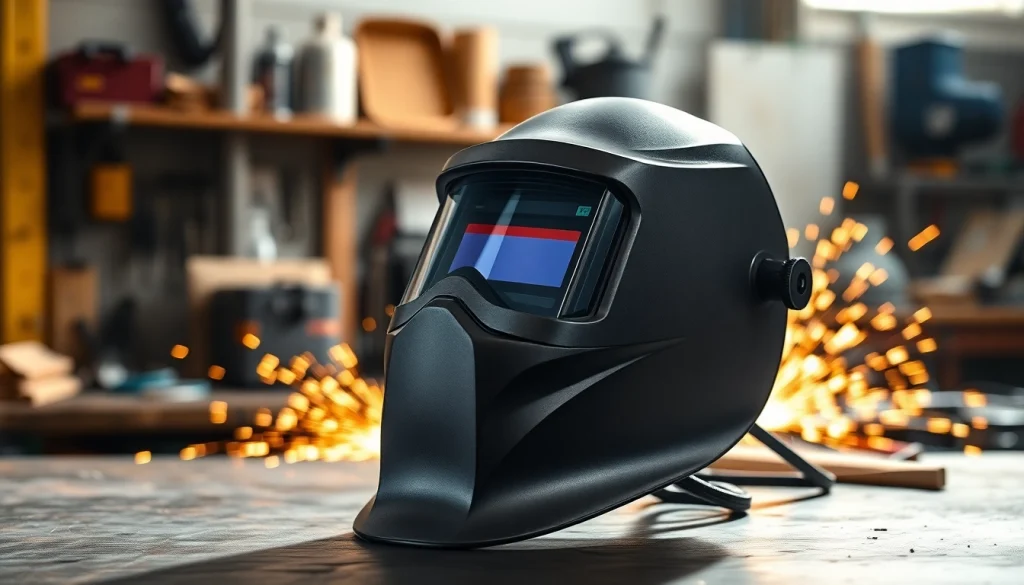Understanding Welding Masks
Welding is a critical skill in numerous industries, spanning construction, manufacturing, and repairs. Not only does it require technical precision, but it also demands safety measures to protect the welder from harmful exposures. Central to these safety measures is the welding mask, an essential piece of personal protective equipment (PPE). This article delves into the intricacies of welding masks, covering types, key features, safety standards, and much more to help you make informed decisions whether you are a novice or a seasoned professional.
What is a Welding Mask?
A welding mask, often referred to as a welding helmet, is designed to protect the eyes, face, and neck of the welder from hazards associated with the welding process. These hazards can include intense light, heat, and harmful fumes produced during welding operations. A quality welding mask provides critical protection, ensuring that the welder can focus entirely on the task without the distraction of safety concerns.
Types of Welding Masks Available
There are several types of welding masks, each designed for specific applications and welding techniques:
- Passive Welding Masks: These traditional helmets feature fixed shade lenses that offer a constant level of protection against harmful light. They are effective but can require the welder to lift the mask frequently to see clearly.
- Auto-Darkening Welding Masks: Equipped with special sensors, these masks automatically adjust the lens shade based on the brightness of the welding arc. This feature allows for seamless transitions between seeing and welding, improving overall workflow.
- Pancake Welding Hoods: These unique designs are lightweight and ideal for specific applications, particularly in tight spaces. They conform closely to the face for added protection and visibility.
- Combination Masks: These devices may offer additional features such as respiratory protection, making them suitable for welders working in environments with high levels of hazardous fumes.
Key Features to Look For
When selecting a welding mask, several features should be prioritized to ensure maximum safety and functionality:
- Lens Shade: A lens with adjustable shade settings can adapt to different welding types, allowing versatility.
- Weight and Comfort: Ensure the mask is lightweight and well-padded for long-wear comfort.
- Viewing Area: Look for masks with a larger viewing area for improved visibility of the work area.
- Safety Rating: Consider masks that comply with industry standards such as ANSI Z87.1 for eye and face protection.
- Durability: The materials should withstand the rigors of welding, including heat and potential impacts.
Safety Standards and Certifications
Adhering to safety standards is crucial in maintaining a safe working environment in welding. The standards set forth guidelines that manufacturers must follow to ensure their products provide adequate protection.
Importance of Compliance
Compliance with safety standards not only protects the welder but also helps organizations minimize liability risks. Using non-compliant equipment can lead to injuries and legal issues. Therefore, understand the standards applicable to welding masks.
Popular Safety Certifications
Some significant standards and certifications to look for include:
- ANSI Z87.1: This certification indicates that the mask meets the American National Standards Institute’s requirements for safety glasses and face shields.
- OSHA Compliance: This ensures the equipment used complies with the Occupational Safety and Health Administration’s regulations.
- ISO Standards: Various international standards relevant to protective equipment may be applicable, depending on the manufacturer.
How to Verify Compliance
To verify compliance, always look for labels and documentation provided with the welding mask. Trusted suppliers will provide proof of compliance with necessary standards and certifications to ensure safety.
Choosing the Best Welding Mask for Your Project
Different welding projects require different types of masks. Understanding how to select the right mask based on project requirements is crucial to ensuring both efficiency and safety.
Factors Affecting Your Choice
When selecting a welding mask, consider the following factors:
- Welding Process: The type of welding you are doing—MIG, TIG, or stick welding—will dictate the type of mask needed due to the differing light intensity and heat levels produced.
- Environment: Consider the work environment. Will you be in an open space or a confined one? This can affect visibility and comfort.
- Personal Preference: Individual comfort and fit also matter. Trying on different styles can help find one that suits your needs.
Welding Techniques and Their Mask Requirements
Various welding techniques come with specific requirements for personal protective equipment:
- TIG Welding: Generally requires a mask that can efficiently handle different lighting conditions as it uses lower temperatures and produces less intense light.
- MIG Welding: Requires an auto-darkening mask due to the flashing light and spatter produced during the process.
- Stick Welding: Similar to MIG, this process requires good light protection and often benefits from a mask with a durable build.
Reviews of Leading Welding Masks
To illustrate what to look for in a good welding mask, here are reviews of some leading models on the market:
- Miller Digital Infinity: Known for its expansive viewing area and cutting-edge auto-darkening technology, this mask is popular among professionals.
- Lewis G601: A robust choice for those seeking durability and affordability. It comes with a fixed lens but offers excellent UV/IR protection.
- Lincoln Electric Viking 3350: Praised for its comfort and clarity, this auto-darkening helmet features a wide viewing area that is beneficial for intricate projects.
Proper Maintenance of Your Welding Mask
Maintaining your welding mask is key to ensuring it provides the best protection over time. Proper care will extend the life of your equipment and enhance safety during welding activities.
Cleaning Techniques
Regular cleaning is essential for maintaining visibility and function. Use a soft, damp cloth to wipe down the exterior and interior of the lens. Avoid abrasive materials that could scratch the lens or damage the protective coating.
Storage Best Practices
Store your welding mask in a cool, dry place, preferably in a protective case to avoid scratches and damage. This practice prevents premature wear and tear, ensuring your mask remains functional for years.
When to Replace Your Mask
Welding masks should be replaced if you notice significant scratches, lenses that do not darken correctly, or if the mask shows signs of physical wear. Staying aware of these indicators will prevent accidents and maintain safety standards.
Welding Mask Accessories and Add-ons
Enhancing the functionality of your welding mask can improve safety and comfort during welding projects. Here are some accessories to consider:
Optional Accessories to Enhance Safety
Accessories such as external protective covers, magnifying lenses, or cooling fans can enhance the performance of your welding mask. These add-ons can adapt the mask to various working conditions, improving overall usability.
Importance of Correct Fit
A proper fit is crucial for any PPE, including welding masks. Poorly fitting masks can result in gaps where harmful light or sparks can enter, leading to potential injuries. Ensure your mask is adjustable and fits snugly against your face.
Customization Options Available
Many manufacturers offer customization options ranging from personalized graphics to specific lens shades tailored to particular types of welding. Customization not only boosts aesthetics but also ensures the mask meets individual needs effectively.



